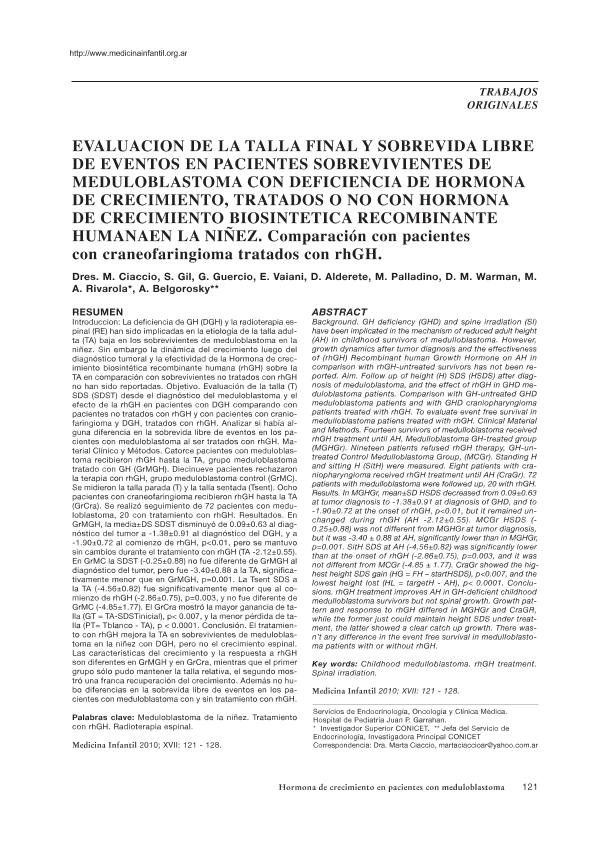Artículo
Introducción: La deficiencia de GH(DGH)Yla radioterapia espinal (RE)han sido implicadas en la etiología de la talla adulta (TA)baja en los sobrevivientes de meduloblastoma en la niñez. Sin embargo la dinámica del crecimiento luego del diagnóstico tumoral y la efectividad de la Hormona de crecimiento biosintética recombinante humana (rhGH) sobre la TA en comparación con sobrevivientes no tratados con rhGH no han sido reportadas. Objetivo. Evaluación de la talla (T) SDS (SDST) desde el diagnóstico del meduloblastoma y el efecto de la rhGH en pacientes con DGH comparando con pacientes no tratados con rhGHy con pacientes con craniofaringioma y DGH,tratados con rhGH. Analizar si había alguna diferencia en la sobrevida libre de eventos en los pacientes con meduloblastoma al ser tratados con rhGH. Material Clínico y Métodos. Catorce pacientes con meduloblastoma recibieron rhGH hasta la TA, grupo meduloblastoma tratado con GH (GrMGH).Diecinueve pacientes rechazaron laterapia con rhGH,grupomeduloblastomacontrol(GrMC). Semidieronla talla parada(T)y la talla sentada (Tsent).Ocho pacientes con craneofaringioma recibieron rhGH hasta la TA (GrCra).Se realizóseguimientode 72 pacientes con meduloblastoma, 20 con tratamiento con rhGH. Resultados. En GrMGH,la media:l:DS SDST disminuyó de 0.09:1:0.63 al diagnóstico del tumor a -1.38:1:0.91 al diagnóstico del DGH, ya -1.90:1:0.72 al comienzo de rhGH, p<0.01, pero se mantuvo sin cambios durante el tratamiento con rhGH (TA-2.12:1:0.55). En GrMCla SDST (-0.25:1:0.88)no fue diferente de GrMGHal diagnóstico del tumor, pero fue -3.40:1:0.88a la TA,significativamente menor que en GrMGH, p=0.001. La Tsent SDS a la TA (-4.56:1:0.82) fue significativamente menor que al comienzo de rhGH (-2.86:1:0.75), p=0.003, y no fue diferente de GrMC (-4.85:1:1.77).El GrCra mostró la mayor ganancia de talla( GT=TA-SDSTinicial), p< 0.007, Y la menor pérdida de talla (PT= Tblanco -TA), P < 0.0001. Conclusión. El tratamiento con rhGH mejora la TAen sobrevivientes de meduloblastoma en la niñez con DGH, pero no el crecimiento espinal. Las características del crecimiento y la respuesta a rhGH son diferentes en GrMGH y en GrCra, mientras que el primer grupo sólo pudo mantener la talla relativa, el segundo mostró una franca recuperación del crecimiento. Además no hubo diferencias en la sobrevida libre de eventos en los pacientes con meduloblastoma con y sin tratamiento con rhGH. Background. GH deficiency (GHD) and spine irradiation (SI) have been implicated in the mechanism of reduced adult height (AH) in childhood survivors of medulloblastoma. However, growth dynamics after tumor diagnosis and the effectiveness of (rhGH) Recombinant human Growth Hormone on AH in comparison with rhGH-untreated survivors has not been reported. Aim. Follow up of height (H) SDS (HSDS) after diagnosis of meduloblastoma, and the effect of rhGH in GHD meduloblastoma patients. Comparison with GH-untreated GHD meduloblastoma patients and with GHD craniopharyngioma patients treated with rhGH. To evaluate event free survival in medulloblastoma patiens treated with rhGH. Clinical Material and Methods. Fourteen survivors of medulloblastoma received rhGH treatment until AH, Medulloblastoma GH-treated group (MGHGr). Nineteen patients refused rhGH therapy, GH-untreated Control Medulloblastoma Group, (MCGr). Standing H and sitting H (SitH) were measured. Eight patients with craniopharyngioma received rhGH treatment until AH (CraGr). 72 patients with medulloblastoma were followed up, 20 with rhGH. Results. In MGHGr, mean±SD HSDS decreased from 0.09±0.63 at tumor diagnosis to -1.38±0.91 at diagnosis of GHD, and to -1.90±0.72 at the onset of rhGH, p<0.01, but it remained unchanged during rhGH (AH -2.12±0.55). MCGr HSDS (- 0.25±0.88) was not different from MGHGr at tumor diagnosis, but it was -3.40 ± 0.88 at AH, significantly lower than in MGHGr, p=0.001. SitH SDS at AH (-4.56±0.82) was significantly lower than at the onset of rhGH (-2.86±0.75), p=0.003, and it was not different from MCGr (-4.85 ± 1.77). CraGr showed the highest height SDS gain (HG = FH – startHSDS), p<0.007, and the lowest height lost (HL = targetH - AH), p< 0.0001. Conclusions. rhGH treatment improves AH in GH-deficient childhood medulloblastoma survivors but not spinal growth. Growth pattern and response to rhGH differed in MGHGr and CraGR, while the former just could maintain height SDS under treatment, the latter showed a clear catch up growth. There wasn’t any difference in the event free survival in medulloblastoma patients with or without rhGH.
Evaluación de la talla final y sobrevida libre de eventos en pacientes sobrevivientes de meduloblastoma con deficiencia de hormona de crecimiento, tratados o no con hormona de crecimiento biosintética recombinante humana en la niñez: Comparación con pacientes con craneofaringioma tratados con rhGH
Ciaccio, Marta Graciela Cristina; Gil, S.; Guercio, Gabriela Viviana ; Vaiani, Elisa; Alderete, D.; Paladino, M.; Warman, Diana Mónica; Rivarola, Marco Aurelio
; Vaiani, Elisa; Alderete, D.; Paladino, M.; Warman, Diana Mónica; Rivarola, Marco Aurelio ; Belgorosky, Alicia
; Belgorosky, Alicia
 ; Vaiani, Elisa; Alderete, D.; Paladino, M.; Warman, Diana Mónica; Rivarola, Marco Aurelio
; Vaiani, Elisa; Alderete, D.; Paladino, M.; Warman, Diana Mónica; Rivarola, Marco Aurelio ; Belgorosky, Alicia
; Belgorosky, Alicia
Fecha de publicación:
06/2010
Editorial:
Fundaciòn Hospital de Pediatría "Prof. Dr. Juan P. Garrahan"
Revista:
Medicina Infantil
ISSN:
0328-0160
Idioma:
Español
Tipo de recurso:
Artículo publicado
Clasificación temática:
Resumen
Palabras clave:
Meduloblastoma de la niñez
,
Tratamiento con rhGH
,
Radioterapia espinal
Archivos asociados
Licencia
Identificadores
Colecciones
Articulos(SEDE CENTRAL)
Articulos de SEDE CENTRAL
Articulos de SEDE CENTRAL
Citación
Ciaccio, Marta Graciela Cristina; Gil, S.; Guercio, Gabriela Viviana; Vaiani, Elisa; Alderete, D.; et al.; Evaluación de la talla final y sobrevida libre de eventos en pacientes sobrevivientes de meduloblastoma con deficiencia de hormona de crecimiento, tratados o no con hormona de crecimiento biosintética recombinante humana en la niñez: Comparación con pacientes con craneofaringioma tratados con rhGH; Fundaciòn Hospital de Pediatría "Prof. Dr. Juan P. Garrahan"; Medicina Infantil; 17; 2; 6-2010; 121-128
Compartir



